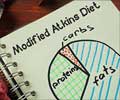Researchers at the University of Florida have found in a study on lab rats that a calorie-restricted diet, when started in early adulthood, can help limit muscle loss in aging adults.
According //to researchers, cutting calories seems to stymie a mitochondrial mishap that may contribute to muscle loss in aging adults.The study has been published in the journal PLoS One.
In rats, the scientists found pockets of excess iron in muscle cell mitochondria, the tiny power plants found in every cell.
The excess iron affects the chemistry inside the mitochondria, sparking the formation of harmful free radicals that can lead a mitochondrion straight to the emergency exit, said Christiaan Leeuwenburgh, Ph.D., a UF professor of aging in the UF College of Medicine and the Institute on Aging.
Leeuwenburgh was the senior author of the study.
"We become less efficient at an old age and we need to understand why this is. One thing, maybe, is the accumulation of redox-active metals in
Advertisement
The suicidal mitochondria can damage the rest of the muscle cell, leading to cell death and perhaps to muscle wasting, a big problem for adults as they reach their mid-70s, Leeuwenburgh added.
Advertisement
The researchers found increasing amounts of iron in the muscle cells of aging rats fed a typical unrestricted diet. The older the rats got, the more iron accumulated in the mitochondria and the more damage was done to its RNA and DNA.
Rats of the same ages that were kept on a calorie-restricted diet - about 60 percent of the food typically ingested - seemed to maintain more normal iron levels in mitochondria, the researchers reported.
"The novel thing here is that iron is accumulating in places it does not normally accumulate," said Mitch Knutson, Ph.D., a UF assistant professor of food science and human nutrition and a study co-author.
"Such iron accumulation in muscle was quite unexpected. This may be of concern because more people are genetically predisposed to developing iron overload than we originally thought," the researcher added.
Source-ANI
RAS/SK













